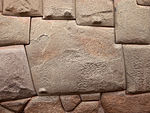
Territorial Revival architecture describes the style of architecture developed in the U.S. state of New Mexico in the 1930s. It derived from New Mexico vernacular Territorial Style, an original style from Santa Fe de Nuevo México following the founding of Albuquerque in 1706. Territorial Revival incorporated elements of traditional regional building techniques with higher style elements. The style was intended to recall the Territorial Style and was extensively employed for New Mexico state government buildings in Santa Fe.
The style was encouraged by a State Planning Board proclamation of 1934, which advocated the redesign of the state capitol in "the local Santa Fe type of architecture." Architect John Gaw Meem, a leading proponent of the related Pueblo Revival architectural movement, is considered to be the initiator of Territorial Revival architecture.
Description and history

The term Territorial architecture describes a variety of architectural features and regional styles in use during the American territorial period, particularly the New Mexico Territory from about 1846 until 1900. Territorial architecture was defined by the incorporation of elements from classical architecture—pediments, columns, and copings—into buildings that otherwise made use of regional architectural elements and materials such as flat roofs, adobe bricks, and wooden porch posts.
In Territorial Revival architecture, these elements were applied to much larger buildings, such as the New Mexico Capitol Complex, than those that existed during the territorial period. The style was also increasingly adapted to domestic architecture—typically residences of one story—in northern New Mexico, especially in the vicinity of Santa Fe and Albuquerque. Territorial Revival doors and windows sometimes featured lintels with pediments or decorative trim reminiscent of Greek Revival architecture, Gothic Revival architecture, and other classical revival styles. Other distinguishing features of the style are the use of adobe construction, low, flat roofs with a sharp brick edging, white-washed milled lumber columns, and sash windows with mullions.
Territorial Revival was developed in response to the increasing popularity of the Spanish-Pueblo Revival style, with which it shares many features and materials. Architect John Gaw Meem began to design homes in what he referred to as 'territorial' style in response to requests from clients, some of whom desired residences with cleaner, more conventional lines and symmetrical masses than were customary of his Pueblo Revival buildings. Meem's client Mrs. Robert Tilney specifically requested that the architect eschew many of customary Pueblo Revival elements for her 1929 house, saying that she wanted "nothing heavy or Indian", "as little Mexican as possible", and that "the interior of the house be American Colonial in spirit." So Meem took the liberty of blending the Spanish-Pueblo stylings reminiscent of Albuquerque's Old Town, which used the then conventional simpler stylings, into a building technique that simplified the "Indian" and "Mexican" forms into a minimalist style, so as to maintain the regional aesthetic. During the Great Depression of the 1930s, Territorial Revival was sometimes preferred to Pueblo Revival, principally because its relative simplicity and symmetry resulted in lower building costs.
The Territorial Revival style is primarily confined to New Mexico, and continues to be popular into the 21st century, particularly for commercial and government buildings, small offices, residences, and strip malls.
Examples
- New Mexico Capitol Complex, Santa Fe
- Hotel Andaluz, Albuquerque
- Los Poblanos Historic Inn, north of Albuquerque
- Charles Bolsius House, Old Fort Lowell, Tucson, Arizona
See also
References
- Kammer, David. "Supreme Court Building - NM". New Mexico Office of the State Historian. Retrieved 23 June 2011.
- Kammer, David. "Buildings Designed by John Gaw Meem, 1925-1959". Office of the New Mexico State Historian. Retrieved 2018-09-15.
- ^ Wilson, Chris (2001). Facing Southwest : the life & houses of John Gaw Meem. Reck, Robert (Photographer) (1st ed.). New York: Norton. pp. 40–45. ISBN 0393730670. OCLC 46866297.
- Dictionary of Architecture and Construction. McGraw-Hill. 2006.
- Massey, James C.; Maxwell, Shirley (September–October 2005). "American Houses, Spanish Styles". Old-House Journal: 83.
| Historicism and Revivalism in architecture and decorative arts | |
|---|---|
| International |
|
| France | |
| Germany, Austria-Hungary | |
| Great Britain | |
| Greece | |
| Italy | |
| Netherlands | |
| Nordic countries | |
| Portugal | |
| Poland | |
| Romania | |
| Russian Empire and USSR | |
| Serbia | |
| Spain | |
| United States | |
| Architecture of the United States | |
|---|---|
| Native and indigenous | |
| Colonial and post-colonial | |
| Early Republic | |
| Mid-19th century | |
| Victorian | |
| Late-19th to mid-20th century |
|
| Post–World War II | |
| Building types and vernacular |
|
| Cities | |
| States | |
| Native American architecture | ||
|---|---|---|
| Styles |  | |
| Building types | ||
| Structures | ||
| Elements | ||
| Spanish / Hispanic Colonial architecture articles | |
|---|---|
| Notable historic centers |
|
| Spanish missions | |
| Lists of buildings | |
| Cathedrals | |
| Churches and monasteries | |
| Fortifications | |
| Bridges and roads | |
| Other building types | |
| Architecture types | |
| Modern Revival styles | |